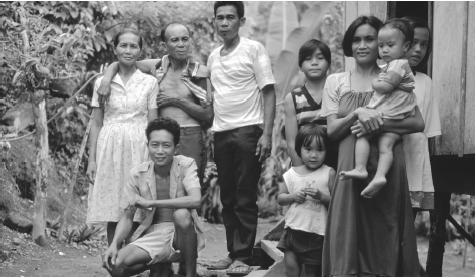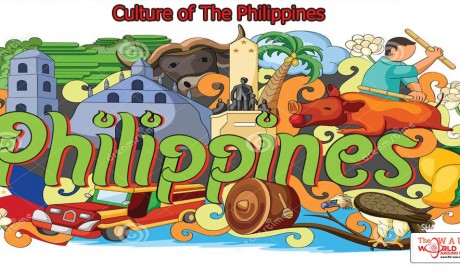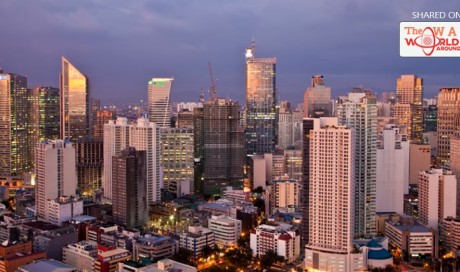Urbanism, Architecture, and the Use of Space
The architecture of the islands shows Spanish influence. Spanish brick churches built during the colonial era dominate the towns. The churches are large and different from traditional construction. It is difficult to imagine how the indigenous population in the seventeenth century was able to build them.

Seaports and government centers had a larger proportion of Spanish buildings with wide verandas and tiled roofs. Towns destroyed during the liberation campaign in World War II, especially in central and northern Luzon, were rebuilt using wood. Areas of Manila destroyed during World War II have been restored to their historical Spanish appearance. Newer buildings in Manila range from standard multistory offices to Western-style gated housing areas for the affluent, to tenements and shacks.
Traditional houses in rural areas are nipa huts constructed of bamboo and roofed with leaves from palm trees or corrugated metal. Cinder blocks are the most commonly building material used. The blocks are plastered and painted on the inside and outside when funds permit. Plasterers add decorative touches to the exterior. Older houses have a "dirty" open-air kitchen for food preparation. Newer, larger houses designate a room as a dirty kitchen in contrast to the "clean" kitchen, which has an eating area where utensils are stored. Enclosed kitchens provide a roof over the cook and keep dogs and chickens from wandering into the cooking area. The roof is pitched so that rain will run off. Middle-class houses and commercial buildings have tiled roofs.
Food and Economy
Food in Daily Life. Filipinos do not consider it a meal if rice is not served. Plain steamed rice is the basis of the diet. Three crops a year are harvested to provide enough rice for the population, and the government keeps surpluses stored for times of drought. Salt water and freshwater of fish and shellfish are eaten daily, served either fresh or salted. Fish, chicken and pork are usually fried, although people are becoming more health-conscious and often choose alternative methods of cooking. Garlic is added to food because it is considered healthful. Filipino food is not spicy. All food is cooked on gas burners or wood or charcoal fires and is allowed to get cold before it is eaten. Rice is cooked first, since it takes longer. When it is ready, rice will be placed on the table while the next items of the meal are prepared and served.
Table knives are not used. Forks and spoons are used for dining. The food is eaten from a spoon. The traditional method of placing food on a banana leaf and eating with one's hands is also used throughout the country. It is acceptable to eat food with one's hands at restaurants as well as in the home.
Breakfast is served at 6 A.M. and consists of food left over from the night before. It is not reheated. Eggs and sausage are served on special occasions. Small buns called pan de sol may be purchased from vendors early in the morning.
At midmorning and in the afternoon, people eat merienda. Since Filipinos are fond of sweet foods, a mixture of instant coffee, evaporated milk, and sugar may be served. Coca-Cola is very popular. Sweet rolls, doughnuts, or a noodle dish may be available. Lunch is a light meal with rice and one other dish, often a fish or meat stew. Fish, pork, or chicken is served at dinner with a soup made of lentils or vegetables. Fatty pork is a favorite. Portions of small cubes of browned pork fat are considered a special dish.
Fruits are abundant all year. Several kinds of banana are eaten, including red and green varieties. Mangoes, the national fruit, are sweet and juicy. A fruit salad with condensed milk and coconut milk is very popular on special occasions.
Vegetables are included as part of a soup or stew. Green beans and potatoes are commonly eaten foods. The leaves of camote, a sweet potato, are used as a salad and soup ingredient. Ube, a bland bright purple potato, is used as a colorful ingredient in cakes and ice cream. Halo-halo, which means "mixture," is a popular dessert that consists of layers of corn kernels, ice cream, small gelatin pieces, cornflakes and shaved ice. Patis, a very salty fish sauce, is placed on the table to be added to any of the dishes.
Fast food has become part of the culture, with national and international chains in many towns. All meals at fast-food restaurant include rice, although French fries also tend to be on the menu. Banana ketchup is preferred, although the international chains serve tomato ketchup. A national chain, Jollibee, has entered the U.S. market with a restaurant in California, where many Filipino immigrants live. The company plans to expand to other cities with Filipino populations.
Food Customs at Ceremonial Occasions. Léchon, a suckling pig that has been roasted until the skin forms a hard brown crust, is served at important occasions. The inside is very fatty. Strips of the skin with attached fat are considered the best pieces. The importance of the host and the occasion are measured by the amount of léchon. served. Blood drained from the pig is used to make dinuguan
Sticky rice prepared with coconut milk and sugarcane syrup is wrapped in banana leaves. Glutinous rice is grown especially for use in this traditional dessert.
Gin and beer are available for men and are accompanied by balut, a duck egg with an embryo. Dog meat is a delicacy throughout the country. It is now illegal to sell dog meat at markets because cases of rabies have occurred when the brains were eaten.
Basic Economy. Agriculture, forestry, and fishing are the occupations of 40 percent of the thirty million people who are employed. Light manufacturing, construction, mining and the service industries provide the remainder of employment opportunities. The unemployment rate is over 9 percent. Fifty percent of the population lives below the poverty line. The Asian financial crisis resulted in a lack of jobs, and the drought period of the El Niño weather cycle has reduced the number of agricultural positions. It is not uncommon for people to "volunteer" as workers in the health care field in hopes of being chosen to work when a position becomes available. People work seven days a week and take additional jobs to maintain or improve their lifestyle or pay for a child's education. Eight hundred thousand citizens work overseas, primarily as merchant seamen, health care, household, or factory workers in Saudi Arabia, Hong Kong, and Taiwan. Over Seas Workers (OSWs) have a governmental agency that looks after their interests. Laws govern hours of work, insurance coverage, and vacation time, but workers may be exploited and mistreated. Recruitment centers are found in all large municipalities. OSWs send $7 billion home each year, providing 4 percent of the gross domestic product.
Land Tenure and Property. Nineteen percent of the land is arable and 46 percent consists of forests and woodlands. Deforestation by legal and illegal loggers with no tree replacement has reduced the number of trees. Large amounts of arable land remain in the hand of absentee landowners who were given land grants during the Spanish colonial period. Although land reform legislation has been passed, loopholes allow owners to retain possession. Those responsible for enacting and enforcing the legislation often come from the same families that own the land. Peasant groups such as the HUKs (People's Liberation Army, or Hukbong Magpapayang Bayan ) in the 1950s and the NPA (New People's Army) at the present time have resorted to guerrilla tactics to provide land for the poor. There is an ongoing demand to clear forests to provide farmland. The clearing technique is slash and burn. Environmentalists are concerned because timber is destroyed at random, eliminating the homes of endangered species of plants and animals.
Commercial Activities. The local market is a key factor in retail trade. Larger municipalities have daily markets, while smaller communities have markets once or twice a week. Trade at the market is conducted in a barter system. Suki relationships are established at the marketplace so that the buyer returns to the same vendor. Markets are divided into "dry" markets where clothing and household items are sold and "wet" markets where food is sold. Sari-sari establishments are small neighborhood stores. They are convenient since they have packaged products and are in the neighborhood, but no fresh foods are available there. In larger towns, supermarkets with fixed prices are adjacent to the market. Electronic equipment, furniture, and clothing have fixed prices and are sold in stores or at kiosks. Shopping malls are found in most provincial capitals. Malls with Western shops are found throughout metropolitan Manila.
Major Industries. Metropolitan Manila is the primary manufacturing area, with 10 percent of the population living there. Manila and the adjacent ports are the best equipped to ship manufactured goods. Manufacturing plants produce electrical and electronic components, chemicals, clothing, and machinery. The provinces produce processed foods, textiles, tobacco products, and construction materials. Manufacturing in the home continues to be common in remote areas.
Trade. Rice, bananas, cashews, pineapple, mangoes, and coconut products are the agricultural products exported to neighboring countries. Exported manufactured products include electronic equipment, machinery, and clothing. The United States, members of the European Union, and Japan are the major trading partners. Imports consists of consumer goods and fuel. The country has mineral and petroleum reserves that have not been developed because of the mountainous terrain and a lack of funding.
Transportation of products is difficult since the highway system beyond metropolitan Manila consists of two-lane roads that are under constant repair and sometimes are washed out by typhoons. Interisland shipping costs add to the expense of manufacturing. Congress, governmental agencies, and the financial community are attempting to find solutions to these problems. The rate of road construction is accelerating and a light rail system is planned. Filipino membership in the Association of South East Asian Nations (ASEAN), a regional trade organization, is an important factor in the development of trade policies.
Division of Labor. In rural areas, lack of mechanization causes the entire family to work in the rice fields. Planting rice seedlings, separating them, replanting, and changing water levels in the fields are done by hand and are labor-intensive. Crops such as tobacco, corn, and sugarcane demand full family participation for short periods during the planting and harvest seasons.
In the cities, traditional roles common to industrialized countries are followed. Men perform heavy physical tasks, while women work as clerks and teachers and in health care.
...[ Continue to next page ]
Share This Post












